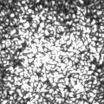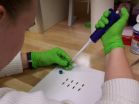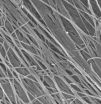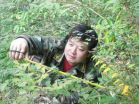(Press-News.org) New research from Uppsala University shows that saturated fat builds more fat and less muscle than polyunsaturated fat. This is the first study on humans to show that the fat composition of food not only influences cholesterol levels in the blood and the risk of cardiovascular disease but also determines where the fat will be stored in the body. The findings have recently been published in the American journal Diabetes.
The study involved 39 young adult men and women of normal weight, who ate 750 extra calories per day for seven weeks. The goal was for them to gain three per cent of their starting weight. The project received considerable attention when it started in 2011, partly because the extra calories were ingested in the form of muffins with high fat content, baked in the lab by Fredrik Rosqvist, a doctoral candidate and first author of the study.
One half of the subjects were random to eat surplus calories from polyunsaturated fat (sunflower oil), while the other half got their surplus calories from saturated fat (palm oil). Both diets contained the same amount of sugar, carbohydrates, fat, and protein; the only difference between muffins was the type of fat.
The increase in body fat and the distribution of fat in the body was measured using a magnetic resonance imaging (MRI scans) before and after the weight gain, as was the muscle mass in the body. Gene activity was measured in the abdominal visceral fat before and after the weight gain with the help of a gene chip that studies several thousand genes at a time.
Despite comparable weight gains between the two diet groups, the surplus consumption of saturated fat caused a markedly greater increase in the amount of fat in the liver and abdomen (especially the fat surrounding the internal organs, visceral fat) in comparison with the surplus consumption of polyunsaturated fat. Moreover the total amount of body fat was greater in the saturated fat group, while, on the other hand, the increase in muscle mass was three times less for those who ate saturated fat compared with those who ate polyunsaturated fat. Thus, gaining weight on excess calories from polyunsaturated fat caused more gain in muscle mass, and less body fat than overeating a similar amount of saturated fat. Since most of us are in positive energy balance, and consequently gain weight slowly but gradually over time, the present results are highly relevant for most Western populations.
"Liver fat and visceral fat seems to contribute to a number of disturbances in metabolism. These findings can therefore be important for individuals with metabolic diseases such as diabetes. If the results regarding increased muscle mass following consumption of polyunsaturated fat can be confirmed in our coming studies, it will potentially be interesting for many elderly people, for whom maintaining muscle mass is of great importance in preventing morbidity", says Ulf Risérus, associate professor at the Department of Public Health and Caring Science and director of the study.
When it comes to the risk of developing diabetes and cardiovascular diseases, it seems more important where in the body the fat is stored than how much fat the body has. Visceral fat, along with a high proportion of fat in the liver, is closely associated with increased risk for developing type-2 diabetes. These fat depots are therefore important targets for new drugs and dietary strategies. A number of studies have indicated that a higher intake of polyunsaturated fats from plant oils and nuts is associated with a decreased risk of type-2 diabetes, but the reasons for this remain unclear.
The present study proposes a potential explanation for such an association, showing that polyunsaturated fatty acids can affect fat distribution in the body more favorably than saturated fats, probably by regulating increased energy combustion or decreased storage of visceral fat in connection with calorie-rich diets.
The researchers were also able to see that over-consumption of saturated fats seems to be able to "turn on" certain genes in fatty tissue that increase the storage of fat in the abdomen and at the same time hamper insulin regulation. Polyunsaturated fats, instead, can "turn on" genes in visceral fat that in turn are linked to reduced storage of fat and improved sugar metabolism in the body. However, more research is required to understand how this occurs in humans.
The discovery may also be a contributing factor regarding the tendency of some individuals to accumulate fat in the liver and abdomen. The new findings suggest that the fat composition of the diet, in the long term, might play a role in preventing obesity-related disorders, like type-2 diabetes, at an early stage, before overweight develops.
"This is of great interest, as we lack preventive treatments for fatty liver and visceral fat today. The new findings also support international dietary recommendations including the new Nordic nutritional recommendations, which, among other things, recommend replacing some saturated fat from meat, butter, and palm oil, for example, with unsaturated fats from plant oils and fatty fish", says Ulf Risérus.
The next step is now to find out in greater detail what happens in the body when we eat the respective fats and to study what the effects are in overweight individuals with elevated risk of type-2 diabetes.
INFORMATION:
The study was conducted at Uppsala University Hospital and Uppsala University in collaboration with the Karolinska Institutet. It was funded by the Swedish Research Council and the Swedish Society of Medicine undertaken within the framework of EXODIAB – Excellence of Diabetes Research in Sweden.
Reference: Rosqvist et al., "Overfeeding Polyunsaturated and Saturated Fat Causes Distinct Effects on Liver and Visceral Fat Accumulation in Humans" Diabetes doi:10.2337/db13-1622 1939-327X
For more information, please contact Associate Professor Ulf Risérus, tel: +46 (0)18-611 79 71, mobile: +46 (0)70- 753 33 16, e-mail: Ulf.Riserus@pubcare.uu.se
Abdominal fat accumulation prevented by unsaturated fat
2014-02-24
ELSE PRESS RELEASES FROM THIS DATE:
Medical researchers use light to quickly and easily measure blood's clotting properties
2014-02-24
VIDEO:
This video shows the rapid "twinkling " or intensity fluctuations of the speckle pattern in a drop of unclotted whole blood. The rapid "twinkling " is due to the fast thermally-driven motion...
Click here for more information.
WASHINGTON, Feb. 24—Defective blood coagulation is one of the leading causes of preventable death in patients who have suffered trauma or undergone surgery. The body's natural defense against severe blood loss is the clotting ...
NIST microanalysis technique makes the most of small nanoparticle samples
2014-02-24
Researchers from the National Institute of Standards and Technology (NIST) and the Food and Drug Administration (FDA) have demonstrated that they can make sensitive chemical analyses of minute samples of nanoparticles by, essentially, roasting them on top of a quartz crystal. The NIST-developed technique, "microscale thermogravimetric analysis," holds promise for studying nanomaterials in biology and the environment, where sample sizes often are quite small and larger-scale analysis won't work.*
Chemical analysis of nanoparticles is a challenging task, and not just because ...
New biological scaffold offers promising foundation for engineered tissues
2014-02-24
Our cells don't live in a vacuum. They are surrounded by a complex, nurturing matrix that is essential for many biological functions, including growth and healing.
In all multicellular organisms, including people, cells make their own extracellular matrix. But in the lab, scientists attempting to grow tissue must provide a scaffold for cells to latch onto as they grow and proliferate. This engineered tissue has potential to repair or replace virtually any part of our bodies.
Typically, researchers construct scaffolds from synthetic materials or natural animal or human ...
Is previous hypoglycemia a risk factor for future hypoglycemic episodes?
2014-02-24
New Rochelle, NY, February 24, 2014—The automatic "threshold suspend" (TS) feature of an insulin pump helps prevent life-threatening hypoglycemic events when the device's sensor detects blood glucose concentrations below the preset threshold. However, in individuals with type 1 diabetes who have had previous episodes of hypoglycemia the TS feature may be less effective at preventing subsequent events, according to important new results from the ASPIRE study published in Diabetes Technology & Therapeutics (DTT), a peer-reviewed journal from Mary Ann Liebert, Inc., publishers. ...
Vitamin water: Measuring essential nutrients in the ocean
2014-02-24
The phrase, 'Eat your vitamins,' applies to marine animals just like humans. Many vitamins, including B-12, are elusive in the ocean environment.
University of Washington researchers used new tools to measure and track B-12 vitamins in the ocean. Once believed to be manufactured only by marine bacteria, the new results show that a whole different class of organism, archaea, can supply this essential vitamin. The results were presented Feb. 24 at the Ocean Sciences meeting in Honolulu.
"The dominant paradigm has been bacteria are out there, making B-12, but it turns ...
OU researcher and team discover disease-causing bacteria in dental plaque preserved for 1,000 years
2014-02-24
When a University of Oklahoma researcher and an international team of experts analyzed the dental calculus or plaque from teeth preserved for 1,000 years, the results revealed human health and dietary information never seen before. The team discovered disease-causing bacteria in a German Medieval population, which is the same or very similar to inflammatory disease-causing bacteria in humans today—unlikely scientific results given modern hygiene and dental health practices.
Christina Warinner, research associate in the Molecular Anthropologies Laboratories, OU College ...
Gauging what it takes to heal a disaster-ravaged forest
2014-02-24
Recovering from natural disasters usually means rebuilding infrastructure and reassembling human lives. Yet ecologically sensitive areas need to heal, too, and scientists are pioneering new methods to assess nature's recovery and guide human intervention.
The epicenter of China's devastating Wenchuan earthquake in 2008 was in the Wolong Nature Reserve, a globally important valuable biodiversity hotspot and home to the beloved and endangered giant pandas. Not only did the quake devastate villages and roads, but the earth split open and swallowed sections of the forests ...
Penn researchers 'design for failure' with model material
2014-02-24
When deciding what materials to use in building something, determining how those materials respond to stress and strain is often the first task. A material's macroscopic, or bulk, properties in this area — whether it can spring back into shape, for example — is generally the product of what is happening on a microscopic scale. When stress causes a material's constituent molecules to rearrange in a way such that they can't go back to their original positions, it is known as "plastic deformation."
Researchers at the University of Pennsylvania have devised a method to study ...
Parents' attitudes about helping their grown children affect their mental health
2014-02-24
Older parents frequently give help to their middle-aged offspring, and their perceptions about giving this help may affect their mental health, according to a team of researchers.
"We usually view the elderly as needy, but our research shows that parents ages 60 and over are giving help to their children, and this support is often associated with lower rates of depression among the older adults," said Lauren Bangerter, Ph.D. student in human development and family studies, Penn State.
The team -- which included researchers at Penn State, the University of Texas ...
Specialized cognitive therapy improves blood sugar control in depressed diabetes patients
2014-02-24
Although maintaining good blood sugar control is crucial for avoiding complications of diabetes, it has been estimated that only about half of patients are successful in meeting target blood glucose levels. The prevalence of depression among diabetes patients – up to twice as high as in the general population – can interfere with patients' ability to manage their diabetes. Now a group of Massachusetts General Hospital (MGH) investigators report that a program of cognitive behavioral therapy that addresses both mood and diabetes self-care led to improved blood sugar control ...







